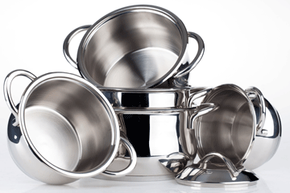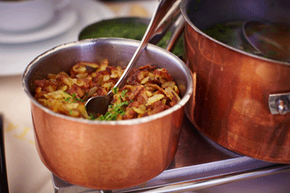First off, copper pans are almost always the most expensive. They cook food evenly and carefully. They're reactive, so if you're cooking something like eggs or an acid, like tomato sauce, you'll run into problems; but if you're cooking something dark-colored and nonacidic, you're golden. Copper is worth the price.
But say you need a nonreactive pan (and you probably do), or you simply can't afford copper? In this case, you're looking at the construction of the pans, and price makes a big difference.
Metal combinations
To achieve the pros of excellent metal conduction but avoid the pitfall of reactivity, higher-quality cookware will combine two metals. For instance, the surface of the pan will be stainless steel, so it won't react with your food, while the inner, unexposed core of the pan is aluminum or the bottom of the pan is copper, both of which are better conductors than stainless steel but are reactive. The reactive metal never touches your food, but it heats it perfectly.
Heating elements
Another big difference between a $200 pan and a $10 pan is the placement of the heating elements, the layer of metal that conducts the heat to your food. In lower-quality pans, the heating element typically is only on the bottom, placing the majority of heat in the middle of the bottom of the pan and causing uneven cooking. Expensive lines have heating elements not only in the bottom but also running up the sides of the pan, so all of the food in the pan gets (roughly) the same amount of heat.
The third issue we're dealing with here isn't a scientific one; it's a simple matter of construction. More expensive pans are just made better. Handles don't jiggle, and if you drop them, they're far less likely to be damaged. They also tend to be better balanced, so they're easier to handle.
So, the quick answer is: Yes, expensive cookware is worth it. But if you don't have a grand or two to drop on a set of All-Clad, it doesn't mean you're totally out of luck. There are ways to put together a nice set of cookware without completely breaking the bank. You just have some choices to make.


